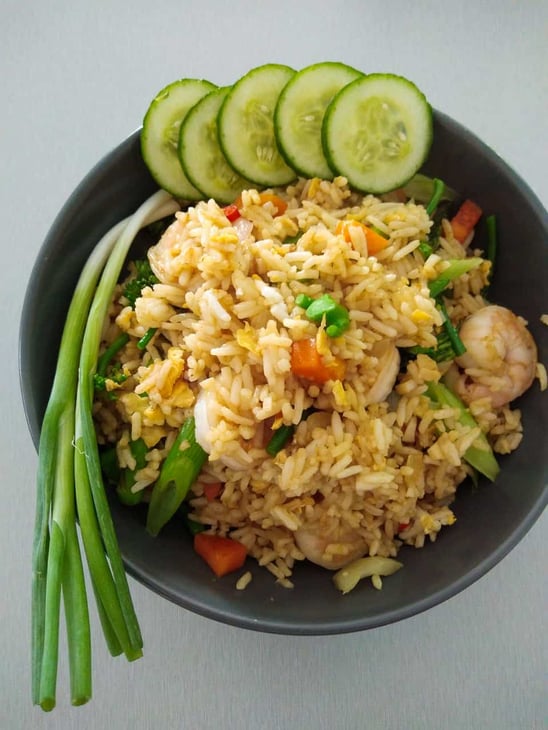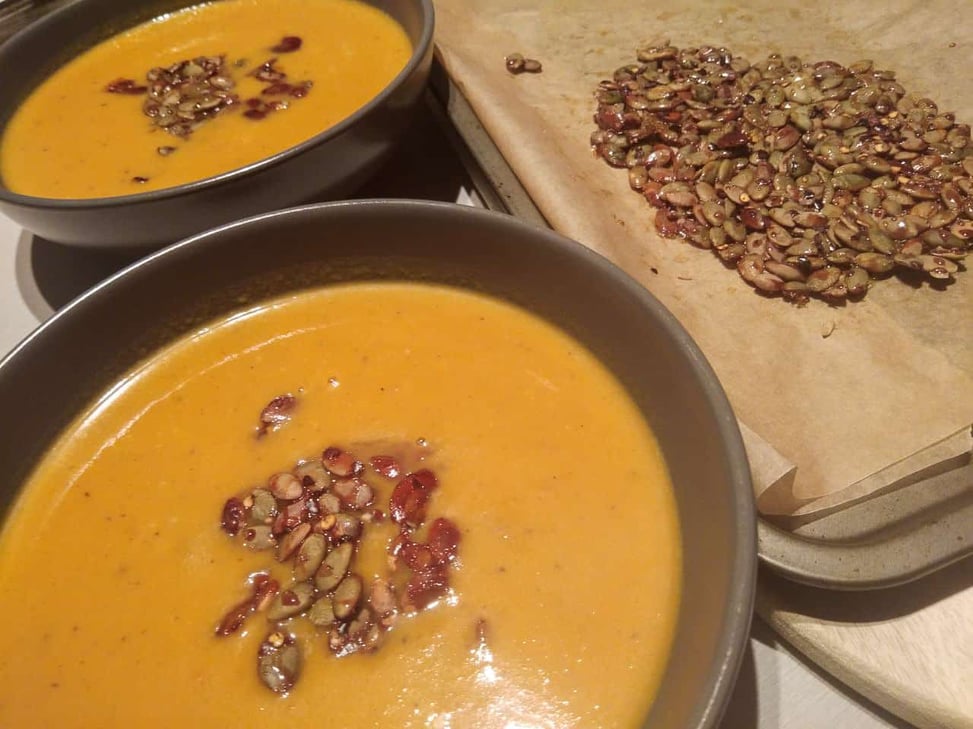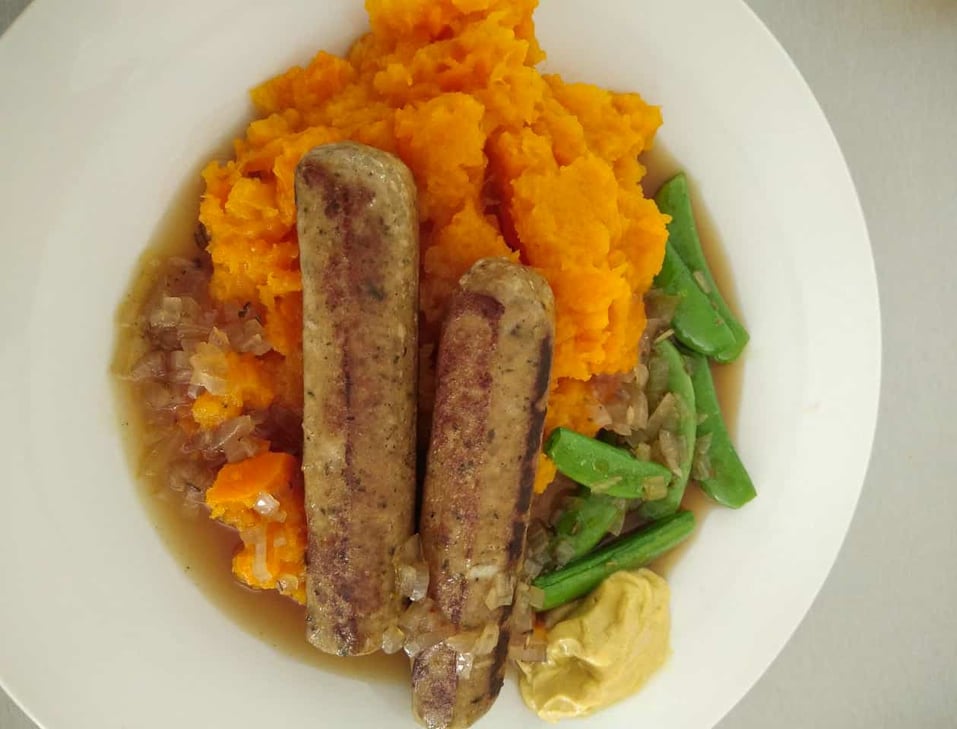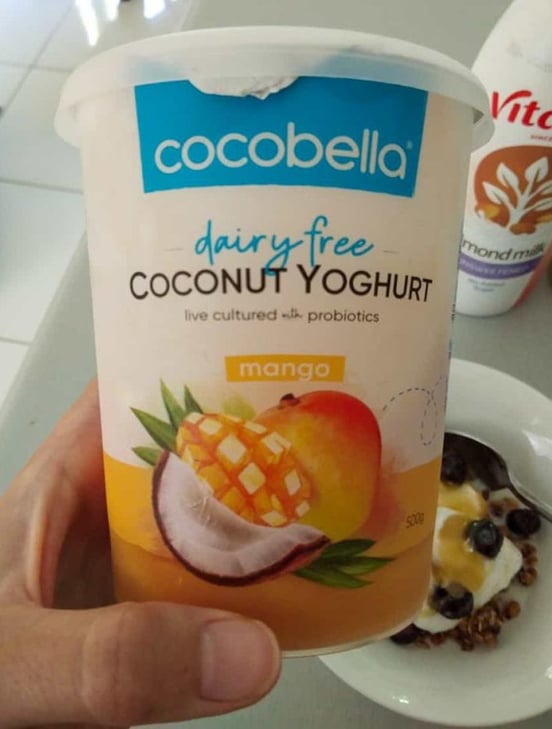Since March I’ve been working on trying to reduce my food footprint, in an effort to slash my overall carbon emissions by 45% this year. In hindsight, it probably wasn’t the best idea to try and do this during a global pandemic when people were bulk buying! However, there’s been so much that we haven’t had control of recently, that focusing on eating sustainably was a welcomed distraction.
Though, to be totally honest, I wasn’t really looking forward to making any drastic dietary changes. As a bit of a foodie, I love all kinds of grub & cuisines and thought I’d nailed eating healthily. But after researching the effects of certain foods on climate change, I knew the only way to eat more sustainably was to do just that.
In this article, I’ll first shed light on some carbon food facts around animal agriculture before suggesting ways to reduce your food footprint, based on things I’ve done myself.
Ready? Take a seat and grab a cuppa because this one’s meaty!

Animal Agriculture V Climate Change
When most of us think about climate change, we immediately think of fossil fuels as being the leading contributor and green energy as the solution. However there’s another often-overlooked, major culprit.
Meat lovers, you may want to take a seat before I tell you this.
Animal agriculture is the second largest contributor to climate change. 😱
Holy cow.

In a 2006 report named ‘Livestock’s Long Shadow‘, The United Nations stated that animal agriculture is responsible for at least 18 percent of all worldwide greenhouse gas emissions. That’s more than the entire transportation sector, which is 13% in comparison.
I’ve been worried all this time about flying too much, but eating beef 3-5 times per week annually emits the same CO2 as taking five return flights from the UK to Malaga.
And it’s likely that this percentage is underestimated.

A few years ago, do you remember when we were all laughing about how cow farts was a huge contributor to methane emissions? Well, more of it actually comes from their burps! Some farmers are even trying to breed cattle that belch less so they produce less of it.
This greenhouse gas has a global warming potential that’s 33 times higher than CO2 and more recently, NASA discovered that the UN had under-calculated methane emissions from cattle in their report, by like, 11 per cent.
But that’s not the end of what comes out of cows. There’s another powerful gas that contributes to climate change which comes from their crap.
Cow waste releases huge amounts of methane and nitrous oxide (which has 296 times more global warming potential than CO2 🤯), and sadly, there’s A SHITLOAD of it.

But the most grim report I read was a study by The Worldwatch Institute who concluded that animal agriculture is the leading cause of global warming. They state that when methane, respiration and the loss of carbon sinks are properly accounted for, then animal agriculture is responsible for 51% of human-caused climate change. 😳 How crazy is that?!
Apparently the UN overlooked those points.
I don’t know about you but all these stats are a lot to take in. 🤯 So let’s take a quick ad break and see the Queen of England’s secret obsession, as well as a clip from Animals Australia.
AD BREAK
View this post on Instagram
The effects of a meat-based diet on nature

Over Christmas I visited the Atherton Tablelands, a hinterland that was painted with rainforests millions of years ago. It was also home to a flourishing abundance of native wildlife.
When colonials first discovered it’s logging & agricultural potential, a whopping 600’000 hectares was cleared to make way for farming. We’re talking big numbers here, so for some perspective that’s approximately 112’1240 football fields.
It still has pockets of protected forests left, but now it’s better known for being a North Queensland supermarket, producing all kinds of fruit, vegetables, meat & dairy.
If I asked you to estimate how much of that 600’000 hectares is used only for rearing dairy & beef cattle, could you guess? 🤔

Out of that 600’000 ha, 558’800 of it is used for livestock! 😱
How bonkers is that. That was once a habitat for endemic wildlife.
Even in the UK, I read an article recently in The Guardian which stated that the country only produces enough food to sustain half of the population. This is largely to do with the fact that out of the six million hectares of cultivatable land in Britain- more than 5 million, eight hundred and thirty-two thousand of it is used for crops to feed livestock and processed foods! These stats are nuts.
When I dug a bit further, I found out that Queensland is in similar disarray. In 2017, the state was branded a global “deforestation hotspot” when over 400’000 hectares was stripped, primarily to make way for pastoral land.
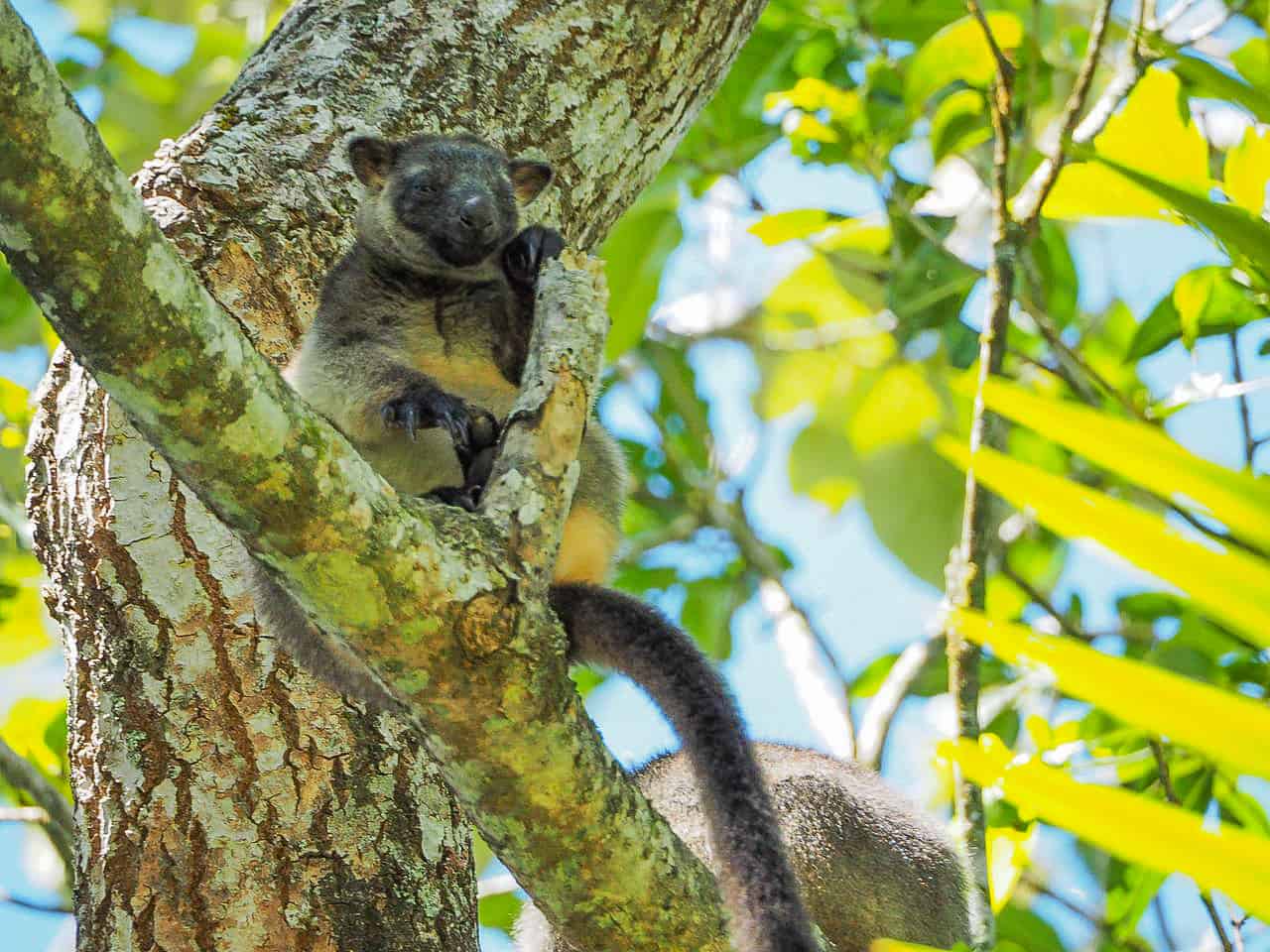
In fact, all over the world, an acre of rainforest is cleared every second to make way for animal agriculture. It also accounts for up to 91% of land clearing in the Amazon.
To say that species have suffered because of it is putting it lightly. Humanity is calculated to have wiped out 60% of wild animal populations since 1970, and closer to home, the Atherton Tablelands now has over 44 mammals, reptiles, birds and fish that are vulnerable, endangered or extinct as a result.
I realise that’s a lot of doom & gloom facts, which isn’t perhaps the best timing during a catastrophic pandemic. But in a way, a lot of it is connected to the coronavirus and if we’re learning anything right now, it’s to rethink how we interact with the planet.
FACT

All of this data really had be thinking. With animal agriculture being the second biggest contributor of greenhouse gasses, a major source of water depletion, the biggest cause of deforestation, mass extinction, habitat loss & ocean dead zones- is eating a meat-based diet sustainable?
Our global population has been increasing at a crazy rate, more than doubling since 1950. At the same time, zoonotic transfer, which is believed to have been the cause of a number of viruses like COVID-19, SARS and MERS, has significantly risen in the past 3 decades. Even The UN and WHO said the pandemic resulted from the destruction of nature.
If the world’s population will reach 10 billion as predicted by 2050, then these problems are only going to get worse. So for all the factors mentioned above, one thing’s for sure. A greater plant based diet is the way to go.

Ways We Can Reduce Our Food Footprint
Over the course of the past 3 months I’ve been making lots of gradual and simple changes to my diet, the types of food I buy and where I source them from. Ultimately, there’s one main way we can reduce our food footprint today (I think you can guess), however there’s still a lot of other stuff we can improve too.
Here’s some of the things I’ve achieved so far in 8 easy steps.

1. Buy Seasonal, Locally Sourced Food
The carbon miles that comes from importing goods can be huge, and I know that when I lived in Malaysia I was buying A LOT of Western foods that couldn’t be sourced locally.
Now I don’t really have that problem, and pretty much all of my favourite grub is made here in Australia. Compared to say the UK, I’m also quite lucky that we don’t rely on other countries for an array of fresh fruit & veg. But as much as possible, I’m favouring produce that has the ‘Australian Made, Australian Grown’ label.

It’s also easy to get stuck always buying the same ingredients, so I’m making an effort to mix it up more & make sure it’s seasonal.
Often it’s easy to spot what’s ‘in’ just by seeing what local food is abundant & ripe, so I’ve been grabbing more of that. And if it’s a new ingredient, I’ve just worked out how to cook it later!

2. Shop From Markets
It’s been harder to do this recently as the markets have been closed during the pandemic, but I’m looking to do a veg shop once a week at our Sunday Markets.
There are so many perks to this. Firstly, you’re supporting local farmers who get about 30% more in profits than if they sold their produce to the supermarkets.

The food will also be cheaper, fresher AND have less carbon miles.
Produce that reaches the supermarket has to firstly get from the farms to a distribution point where it sits until it’s driven to stores. This process takes a minimum of 7 days, whereas it can reach the markets in less time.
It’s a quadruple win.

3. Bring Back Home Cooking
Hands up! I’m often guilty of choosing easy ready-made meals for lunch, and in KL I was TERRIBLE for takeaways. But I’ve made a big effort to DIY it more, which is helped by the fact that I live too remotely for Uber Eats.
So I’ve been making much more from scratch like rice, soups and mashed potatoes instead of grabbing a ready-made, and I even started cooking my own desserts… which the Sailor is all for. 😄
Bulk making and saving the rest for another dinner or freezing it is a good way to go too.

4. Reduce Food Wastage
Whenever something looks on the out, it’s amazing how many ingredients are suited to plonking in a stir-fry or soup. I’ve been working towards MINIMAL food waste at home and surprised myself with a few new dishes, like accidentally making my own version of Thai rice soup (Kao Tom) for breakfast!
So many meals throughout time were invented using leftovers- like paella, pizza and casseroles. Or were preserved through pickling, potting, dehydrating, salt curing, smoking or fermenting. Try it out!

I’ve also started washing and storing all my vegetables in Tupperware as soon as I get home so it keeps for longer. It’s been a game changer- even Bok Choy which usually goes limp after a day in the fridge, now keeps for over a week.
And if all else fails, the freezer works a treat. 😉

5. Use The Whole Ingredient
We often discard many parts of veg, herbs and fruit when actually, a lot of it is edible and can be delicious. For example coriander roots are used in Thai curry pastes, or if you bake a whole cauliflower, then the leaves become crunchy and are actually pukka.

Using the whole ingredient not only enables you to get more out of what you buy, but it minimises food waste and prevents excess carbon emissions from it rotting in a landfill somewhere.
I’m still working on my ability to use more, but chefs like Simon Toohey and Ottolenghi are helping to give ideas on how to utilise the whole ingredient.

6. Grow Your Own
Hands up- I’m crap at keeping plants alive! Usually because there’s so much that wants to eat them here in the tropics.
But I’ve been using so many herbs recently that it makes sense to grow more to home, and it’s hugely satisfying when I can keep them alive. Plus, the more you grow = less food miles.
So we’ve extended our food garden and brought a greenhouse from Bunnings Warehouse to keep the mini-beasts out. Then we had to buy a bigger 4-tier greenhouse because the tomatoes grew like they were on steroids!

Now it’s so nice to step outside and pick the herbs I need fresh from the garden. Although I have to remember not to over-harvest them as I already accidentally killed my basil plant by taking all its leaves! The basil pesto was pukka though.
7. Eat More Plant-Based Foods & Reduce Meat Consumption
According to a University of Oxford study, cutting out meat & dairy from your diet can reduce your carbon food footprint by 58 percent – half of which, are emissions from beef & lamb.
I know, I know. If you’re a meat eater and have been your whole life, then the prospect of eating less of it may seem VERY daunting at first. At least it was for me, big time.
But I found that easing into this transition made it much more manageable. Because ultimately it wasn’t just about changing what I ate, it was about changing a mindset. And that took a good month to rewire!

So to begin with, I started off with Meatless Mondays to build a few meat-free recipes into my repertoire.
To help with some ideas, I brought the Simple cookbook from legend Yotam Ottolenghi who has been “making veggies great again” for over a decade. It includes a handful of meat & fish dishes, but it’s otherwise packed with different vegetarian meals and sides- from cold and cooked veggies, to legumes, pasta and rice.
This was going well, and then after a few more weeks, research and watching documentaries Cowspiracy, What The Health and The Game Changers, the Sailor and I decided to see what total veggy looked like. 🥦 Or at least what pescatarian was like, as we were still eating dairy, fish & seafood.
I don’t think I was ready for this step until I’d researched why was it important that I do this. Changing a life-long habit isn’t easy, but understanding the effects of animal agriculture on the environment gave me the drive to give it a go. It was still quite a transition from this point, one I’m still on, but knowing the “why” made it easier.

At the beginning, I was a little worried that I wouldn’t enjoy my food as much, or if meat-free food would sustain me in the same way. I was also concerned that I wouldn’t get enough iron and protein.
But a few things happened.
Firstly, when we ate well, we were much more sustained and felt fuller for longer.
Then all the beans and broccoli turned us into CHRONIC farters! Seriously, I haven’t poofed so much in all my life. 😂
We also really enjoyed the food. I’m big on flavour anyway so haven’t compromised on that, but I was surprised with how I don’t need meat for it.

It was weird at the beginning spending more time in the fruit and veg section at the supermarket, and I was having to change the way I thought about meals as meat wasn’t the hero anymore. I also noticed how much I ate it out of habit rather than the enjoyability factor.
But I’m learning how to pack more favour into veggies, and I’m impressed with how far plant-based alternatives have come. It’s not the same, but a lot of it is flavourful & crammed with more protein.
I’m loving the ‘Bean Supreme’ and ‘Wildly Good’ range at the supermarket which is a good grab and cook vegan option for when you have less time. The fritters are wicked with a salad or chips, or in a wrap as an alternative to protein.
When I have a bit more time on my hands, it’s easy and hugely satisfying to make my own veggy burgers and homemade ‘meat-free’ meatballs etc. Your ingredients go a lot further too.

After just a few days trialling a bigger plant-based diet we noticed some more changes in our body, and bodily functions!
Without going into too much detail, it was a lot easier to do that. 💩 Meat would sometimes clog us up but now we have no problem.
We also don’t feel as heavy and sluggish after each meal, which is great because I usually lag massively in the afternoon- so productivity is up.
And as each week went on, we were surprised to find that our durability when running improved. We stop far less & go for longer- and it’s all through a diet of beans, barley and broccoli!! Who knew. 🤷🏻♀️

Then after a couple of months of going pescatarian, we found a balance that worked for us.
Whilst we love our new diet and I’ve become much more adventurous in the kitchen, trying many new techniques and flavours, we still enjoy eating meat. So now we occasionally have it when we dine out as a treat.
So I guess we’re occasional omnivores now, or flexitarian?! Whatever we are, it feels good.

For some veggy-spiration, I’d highly recommend checking out recipes from:
- Ottolenghi: The veggy king. There’s lots of free recipes on his website or you can buy his Simple cookbook.
- Noorish by Noor: She is freaking awesome. She’s a recipe developer at Ottolenghi’s test kitchen and knows how to bang flavour into veggies. Check her out on Insta.
- Simon Toohey: AKA, Masterchef Australia’s veggy legend. He’s put up some videos and recipes on his new platform Sustainable Earth Network.
- Jamie Oliver: He’s been doing really well in promoting veggy alternatives recently and has a few bangers up his sleeve. Find free recipes on his web, or check out his book Veg.
- Cookie & Kate: Vegetarian blogger Kate has some smashing recipes too. I’ve tried and tested her bean burgers which were the bomb.
I’ll also be writing up some of my favourite tried and tested vegetarian recipes so far, so check back again soon!
8. Eat Less Dairy
Although no animal is slaughtered when eating dairy, it still has a big carbon footprint. And from the research, it’s not exactly the best for our bodies. So I’m doing the following:
Milk
I’ve replaced the white stuff with soy or almond alternatives, which I now much prefer to regular milk as it doesn’t leave that grim aftertaste.
Yoghurt
We’ve been trialling plant-based alternatives made from coconut or nuts. It’s been just as good!

Butter, Cheese & Cream
To be truthful, I probably eat a bit more cheese and sour cream since going more veggy, but I don’t think it’s too bad since I rarely had it before. There is a brand of plant-based cream that I’ll be trialling soon though, baby steps eh.
Be an ethical consumer by ~ Buying Certified Sustainable Seafood

On the whole, CO2 emissions from fish & shellfish is much smaller than other animal proteins, although their footprint does vary depending on where you source it from, the type of fish and how it’s caught.
Farmed fish generally has a bigger carbon footprint than wild ocean caught, because food needs to be produced and given to them. However sometimes they’re the more sustainable option.
But like with animal agriculture, factors other than carbon are at play here too.

According to the United Nations, 3/4 of the world’s ocean fisheries are fully exploited, overexploited or depleted due to the growing global demand for fish.
As such, commercial fishing has boomed. Fleets have got bigger, as have fishing vessels and nets, which inevitably swallow up a lot of untargetted marine life too.
It’s been reported that for each pound of fish caught, up to 5 pounds of unintended marine species also get swept up as by-kill and discarded- from dolphins, to whales, sea turtles and sharks. This is why as much as possible, I’m trying to buy line-caught fish.

Some marine life is also fished so heavily to the point of depletion, so try to ensure you’re buying certified sustainable seafood from Marine Stewardship Council (MSC) & Aquaculture Stewardship Council (ASC), as recommended by WWF.
Here in Australia, MSC certified foods can be purchased at Coles, Woolies, Aldi & more, and include brands like Birds Eye, Findus Jamie Oliver, John West & Sealord.
You should also try to get acquainted with sustainable seafood in your region to find out which fish is better to buy. Here in Oz I’ve been using the Good Fish guide.
* * *

Wow, that was a lot to take in, well done if you made it to the end!
Reducing my food footprint over the last few months has been surprisingly a lot of fun. I’ve learnt a lot along the way about nutrition, flavour packing and sourcing sustainable foods which has steered us on a totally new path.
What’s also been awesome is that the Sailor has been on this journey with me and is totally supportive of a bigger veggy diet. It helped that we were learning together and could discuss the health benefits that we were feeling, but even if he was sceptical of it, I’m confident that the delicious food would win him over!
What about you- are you a vegan/vegetarian/pescatarian/flexitarian or considering Meatless Mondays? How are you finding it? Comment below to share!
